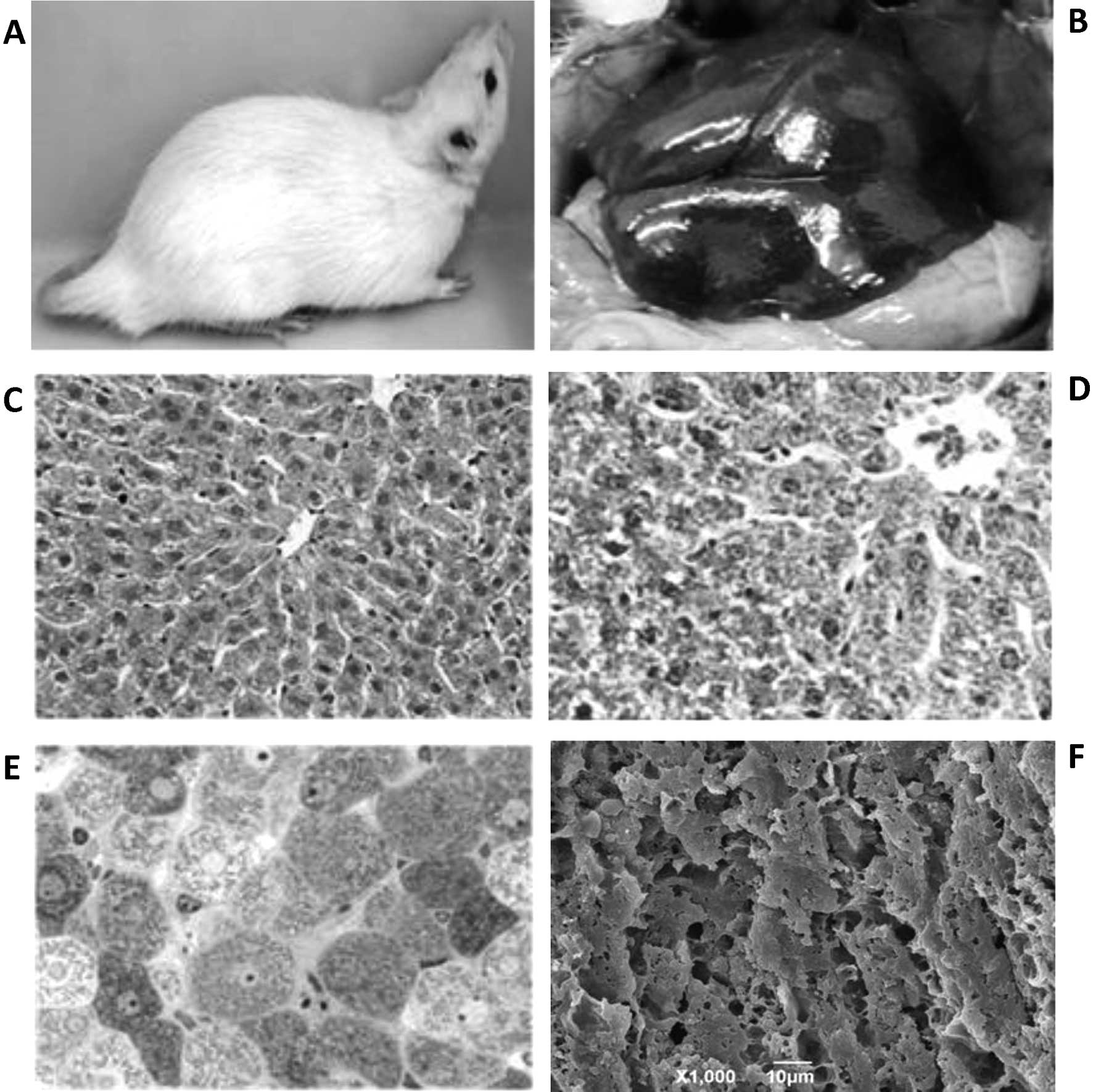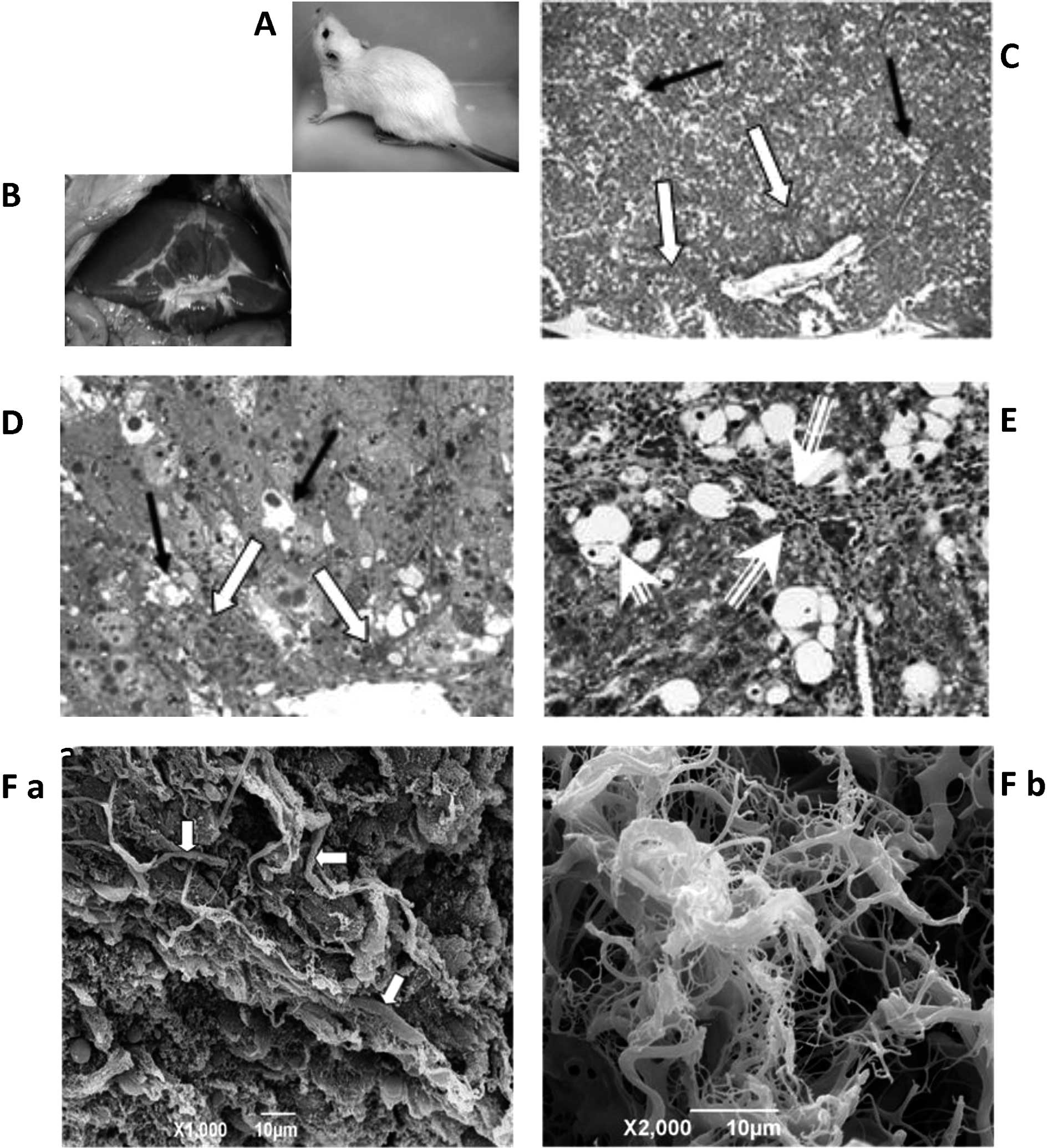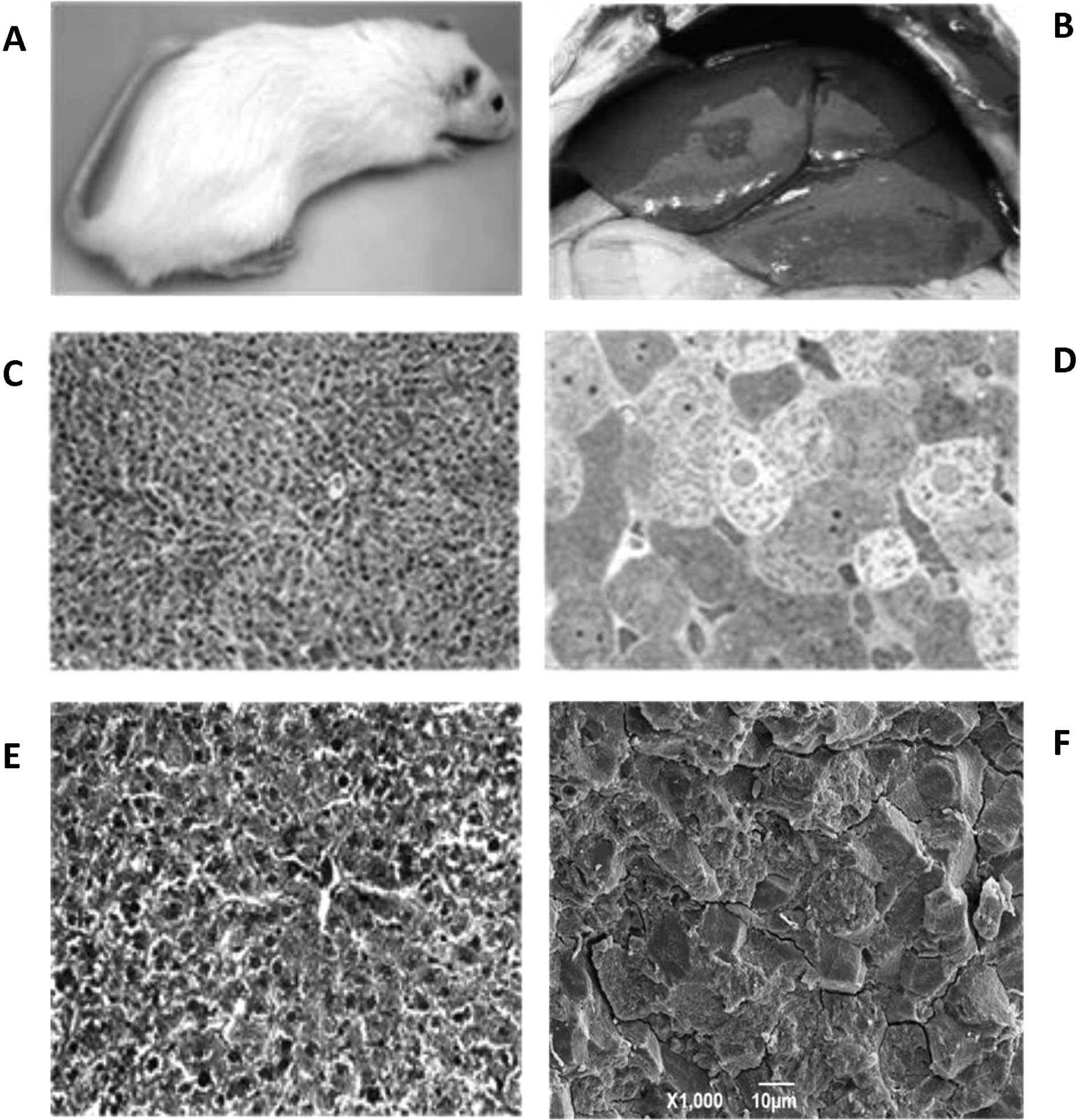|
1.
|
Paz Z and Shoenfeld Y: Anti-fibrosis: to
reverse the irreversible. Clin Rev Allergy Immunol. 38:276–286.
2010. View Article : Google Scholar : PubMed/NCBI
|
|
2.
|
Bateller R and Brenner DA: Liver fibrosis.
J Clin Invest. 115:209–218. 2005. View
Article : Google Scholar
|
|
3.
|
Bissell DM: Hepatic fibrosis as wound
repair: a progress report. J Gastroenterol. 33:295–302. 1998.
View Article : Google Scholar : PubMed/NCBI
|
|
4.
|
Kim HK, Yang TH and Cho HY: Antifibrotic
effects of green tea on in vitro and in vivo models of liver
fibrosis. World J Gastroenterol. 15:5200–5205. 2009. View Article : Google Scholar : PubMed/NCBI
|
|
5.
|
Li CH, Piao DM, Xu WX, Yin ZR, Jin JS and
Shen ZS: Morphological and serum hyaluronic acid, laminin and type
IV collagen changes in dimethylnitrosamine-induced hepatic fibrosis
of rats. World J Gastroenterol. 28:7620–7624. 2005.PubMed/NCBI
|
|
6.
|
Wu J and Zern MA: Hepatic stellate cells:
a target for the treatment of liver fibrosis. J Gastroenterol.
35:665–672. 2000. View Article : Google Scholar : PubMed/NCBI
|
|
7.
|
Al-Bloushi S, Safer AM, Afzal M and Shaker
M: Green tea modulates reserpine toxicity in animal model. J
Toxicol Sci. 34:77–87. 2009. View Article : Google Scholar : PubMed/NCBI
|
|
8.
|
Safer AM, Afzal M, Al-Bloushi S, Rafique M
and Mousa SA: Inhibition property of green tea extract in relation
to reserpine-induced ribosomal strips of rough endoplasmic
reticulum (rER) of the rat kidney proximal tubule cells. J Toxicol
Sci. 34:637–645. 2009. View Article : Google Scholar
|
|
9.
|
Wang XH, Zhao J, Zhang W, Zhang L, Ma R,
Wang L, Zhang S and Tian L: Scanning electron microscopic
observation: three-dimensional architecture of the collagen in
hepatic fibrosis rats. Chin Med J. 120:308–312. 2007.PubMed/NCBI
|
|
10.
|
Borrelli F, Capasso R, Russo A and Ernst
E: Systematic review: green tea and gastrointestinal cancer risk.
Aliment Pharmacol Ther. 19:497–510. 2004. View Article : Google Scholar : PubMed/NCBI
|
|
11.
|
Cooper R, Morre DJ and Morre DM: Medicinal
benefits of green tea: part I. Review of non-cancer health
benefits. J Altern Complement Med. 11:521–528. 2005. View Article : Google Scholar : PubMed/NCBI
|
|
12.
|
Fujita H and Yamagami T:
Anti-hypercholesterolemia effect of Chinese black tea extract in
human subjects with borderline hypercholesterolemia. Nutr Res.
28:450–456. 2008. View Article : Google Scholar : PubMed/NCBI
|
|
13.
|
Gross G, Meyer KG, Pres H, Thielert C,
Tawfik H and Mescheder A: A randomized, double-blind, four-arm
parallel-group, placebo-controlled Phase II/III study to
investigate the clinical efficacy of two galenic formulations of
Polyphenon E in the treatment of external genital warts. J Eur Acad
Dermatol Venereol. 2:1404–1412. 2007. View Article : Google Scholar
|
|
14.
|
Inoue M, Tajima K and Mizutani M: Regular
consumption of green tea and the risk of breast cancer recurrence:
follow-up study from the Hospital-based Epidemiologic Research
Program at Aichi Cancer Center (HERPACC), Japan. Cancer Lett.
167:175–182. 2001. View Article : Google Scholar
|
|
15.
|
Jian L, Xie LP, Lee AH and Binns CW:
Protective effect of green tea against prostate cancer: a
case-control study in southeast China. Int J Cancer. 108:130–135.
2004. View Article : Google Scholar : PubMed/NCBI
|
|
16.
|
Jin X, Zheng RH and Li YM: Green tea
consumption and liver disease: a systematic review. Liver Int.
28:990–996. 2008. View Article : Google Scholar : PubMed/NCBI
|
|
17.
|
Kato A, Minoshima Y, Yamamoto J, Adachi I,
Watson AA and Nash RJ: Protective effects of dietary chamomile tea
on diabetic complications. J Agric Food Chem. 56:8206–8211. 2008.
View Article : Google Scholar : PubMed/NCBI
|
|
18.
|
Kovacs EM, Lejeune MP, Nijs I and
Westerterp-Plantenga MS: Effects of green tea on weight maintenance
after body-weight loss. Br J Nutr. 91:431–437. 2004. View Article : Google Scholar : PubMed/NCBI
|
|
19.
|
Kuriyama S, Shimazu T, Ohmori K, Kikuchi
N, Nakaya N, Nishino Y, Tsubono Y and Tsuji I: Green tea
consumption and mortality due to cardiovascular disease, cancer and
all causes in Japan: the Ohsaki study. JAMA. 296:1255–1265. 2006.
View Article : Google Scholar : PubMed/NCBI
|
|
20.
|
Low Dog T, Riley D and Carter T:
Traditional and alternative therapies for breast cancer. Altern
Ther Health Med. 7:36–47. 2001.PubMed/NCBI
|
|
21.
|
Lyn-Cook BD, Rogers T, Yan Y, Blann EB,
Kadlubar FF and Hammons GJ: Chemopreventive effects of tea extracts
and various components on human pancreatic and prostate tumor cells
in vitro. Nutr Cancer. 35:80–86. 1999. View Article : Google Scholar : PubMed/NCBI
|
|
22.
|
Inoue M, Sasazuki S, Wakai K, Suzuki T,
Matsuo K, Shimazu T, Tsuji I, Tanaka K, Mizoue T, Nagata C, et al:
Green tea consumption and gastric cancer in Japanese: a pooled
analysis of six cohort studies. Gut. 58:1323–1332. 2009. View Article : Google Scholar : PubMed/NCBI
|
|
23.
|
Miura Y, Chiba T, Tomita I, Koizumi H,
Miura S, Umeqaki K, Hara Y, Ikeda M and Tomita T: Tea catechins
prevent the development of atherosclerosis in apoprotein
E-deficient mice. J Nutr. 131:27–32. 2001.PubMed/NCBI
|
|
24.
|
Nagao T, Hase T and Tokimitsu I: A green
tea extract high in catechins reduces body fat and cardiovascular
risks in humans. Obesity (Silver Spring). 15:1473–1483. 2007.
View Article : Google Scholar : PubMed/NCBI
|
|
25.
|
Lotersztajn S, Julien B, Teixeira-Clerc F,
Grenard P and Mallat A: Hepatic fibrosis molecular mechanisms and
drug targets (Review). Annu Rev Pharmacol Toxicol. 45:605–628.
2005. View Article : Google Scholar : PubMed/NCBI
|
|
26.
|
Gressner AM: The cell biology of liver
fibrogenesis – an imbalance of proliferation, growth arrest and
apoptosis of myofibroblasts. Cell Tissue Res. 292:447–452.
1998.
|
|
27.
|
Oh SW, Kim DH, Ha JR and Kim DY:
Anti-fibrotic effects of a methylenedioxybenzene compound, CW209292
on dimethylnitrosamine-induced hepatic fibrosis in rats. Biol Pharm
Bull. 32:1364–1370. 2009. View Article : Google Scholar : PubMed/NCBI
|
|
28.
|
Yang CS: Tea and health. Nutrition.
15:946–949. 1999.
|
|
29.
|
Ohta Y, Kongo M, Sasaki E, Nishida K and
Ishiguro I: Therapeutic effect of melatonin on carbon
tetrachloride-induced acute liver injury in rats. J Pineal Res.
28:119–126. 2000. View Article : Google Scholar : PubMed/NCBI
|
|
30.
|
Salah N, Miller NJ, Paganga G, Tijburg L,
Bolwell GP and Rice-Evans C: Polyphenolic flavanols as scavengers
of aqueous phase radicals and as chain-breaking antioxidants. Arch
Biochem Biophys. 322:339–346. 1995. View Article : Google Scholar : PubMed/NCBI
|
|
31.
|
Gouni-Berthold I and Sachinidis A:
Molecular mechanisms explaining the preventive effects of catechins
on the development of proliferative diseases. Curr Pharm Des.
10:1261–1271. 2004. View Article : Google Scholar : PubMed/NCBI
|
|
32.
|
Mandel S and Youdim MB: Catechin
polyphenols: neurodegeneration and neuroprotection in
neurodegenerative diseases. Free Radic Biol Med. 37:304–317. 2004.
View Article : Google Scholar : PubMed/NCBI
|


















